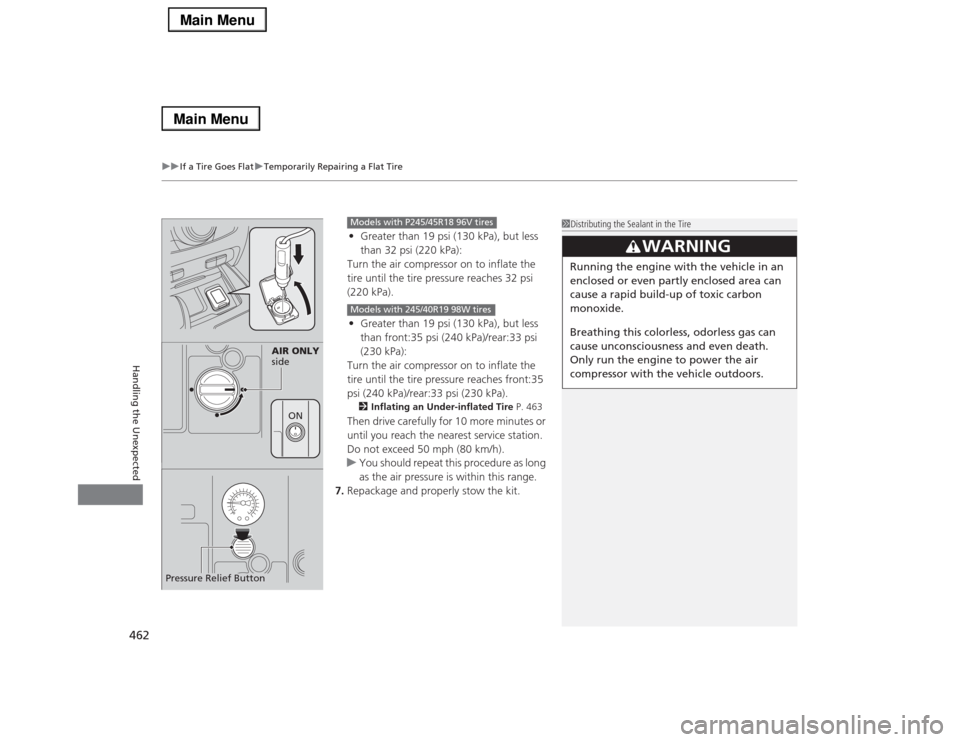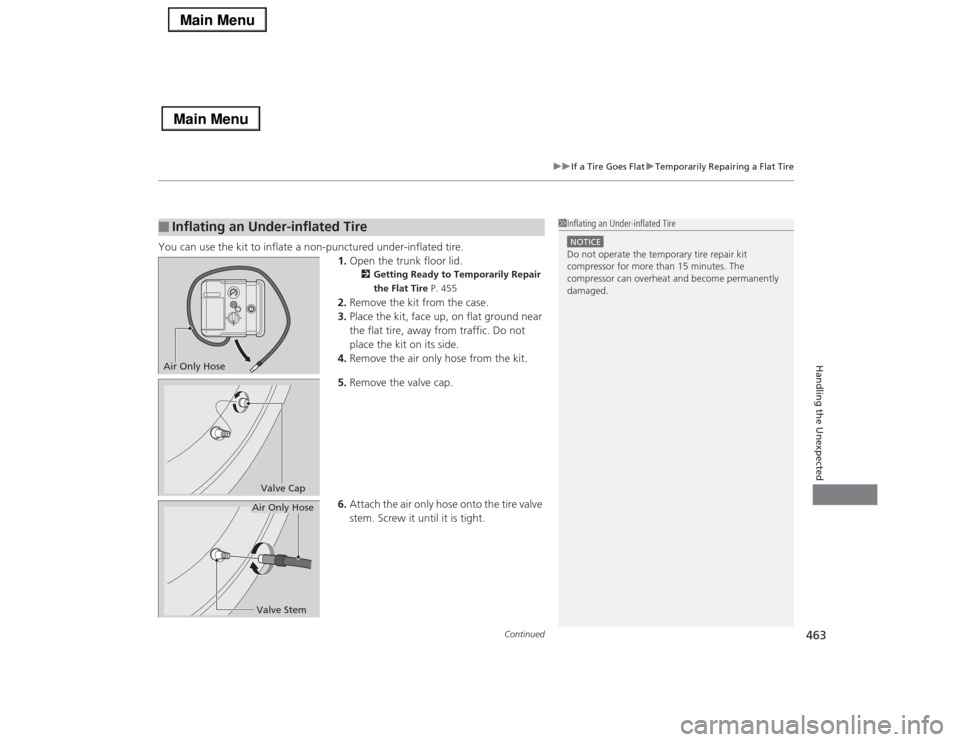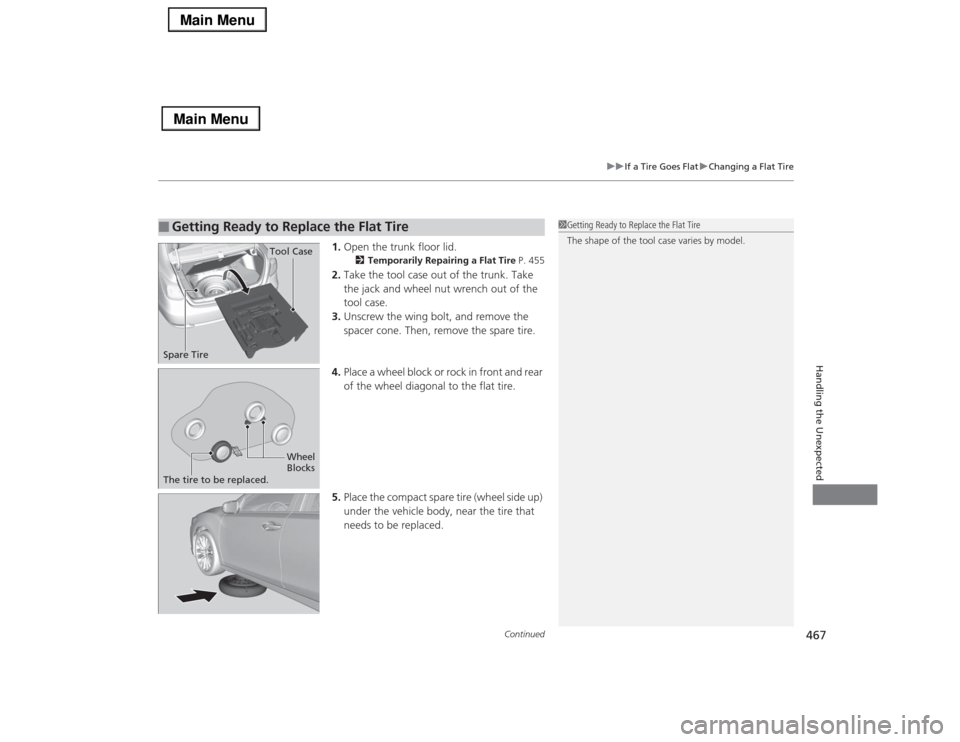Acura RLX 2014 Owner's Manual
Manufacturer: ACURA, Model Year: 2014, Model line: RLX, Model: Acura RLX 2014Pages: 518, PDF Size: 15.83 MB
Page 461 of 518

460
uuIf a Tire Goes FlatuTemporarily Repairing a Flat Tire
Handling the Unexpected
13.Apply the repair notification label to the
flat surface of the wheel.
uThe wheel surface must be clean to
ensure the label adheres properly.
1.Apply the speed restriction label to the
location as shown.
2.Drive the vehicle for about 10 minutes.
uDo not exceed 50 mph (80 km/h).
3.Stop the vehicle in a safe place.
Repair Notification Label
U.S.
Canada■
Distributing the Sealant in the Tire
Speed Restriction LabelU.S.
Canada
Page 462 of 518

461
uuIf a Tire Goes FlatuTemporarily Repairing a Flat Tire
Continued
Handling the Unexpected
4.Recheck the air pressure using the air only
hose on the compressor.
5.Turn the selector switch to AIR ONLY.
uDo not turn the air compressor on to
check the pressure.
2Inflating an Under-inflated Tire P. 463
6.If the air pressure is
•Less than 19 psi (130 kPa):
Do not add air or continue driving. The leak
is too severe. Call for help and have your
vehicle towed.
2Emergency Towing P. 490•32 psi (220 kPa) or more:
•Front:35 psi (240 kPa)/rear:33 psi (230
kPa) or more:
Continue driving for another 10 minutes or
until you reach the nearest service station.
Do not exceed 50 mph (80 km/h).
uIf the air pressure does not go down after
the 10 minute driving, you do not need
to check the pressure any more.
Air Only Hose
Models with P245/45R18 96V tiresModels with 245/40R19 98W tires
Page 463 of 518

uuIf a Tire Goes FlatuTemporarily Repairing a Flat Tire
462Handling the Unexpected
•Greater than 19 psi (130 kPa), but less
than 32 psi (220 kPa):
Turn the air compressor on to inflate the
tire until the tire pressure reaches 32 psi
(220 kPa).
•Greater than 19 psi (130 kPa), but less
than front:35 psi (240 kPa)/rear:33 psi
(230 kPa):
Turn the air compressor on to inflate the
tire until the tire pressure reaches front:35
psi (240 kPa)/rear:33 psi (230 kPa).2Inflating an Under-inflated Tire P. 463Then drive carefully for 10 more minutes or
until you reach the nearest service station.
Do not exceed 50 mph (80 km/h).
uYou should repeat this procedure as long
as the air pressure is within this range.
7.Repackage and properly stow the kit.
AIR ONLY
side
ON
Pressure Relief Button
Models with P245/45R18 96V tiresModels with 245/40R19 98W tires
1Distributing the Sealant in the Tire
33
WARNING
Running the engine with the vehicle in an
enclosed or even partly enclosed area can
cause a rapid build-up of toxic carbon
monoxide.
Breathing this colorless, odorless gas can
cause unconsciousness and even death.
Only run the engine to power the air
compressor with the vehicle outdoors.
Page 464 of 518

Continued
463
uuIf a Tire Goes FlatuTemporarily Repairing a Flat Tire
Handling the Unexpected
You can use the kit to inflate a non-punctured under-inflated tire.
1.Open the trunk floor lid.
2Getting Ready to Temporarily Repair
the Flat Tire P. 455
2.Remove the kit from the case.
3.Place the kit, face up, on flat ground near
the flat tire, away from traffic. Do not
place the kit on its side.
4.Remove the air only hose from the kit.
5.Remove the valve cap.
6.Attach the air only hose onto the tire valve
stem. Screw it until it is tight.
■
Inflating an Under-inflated Tire
1Inflating an Under-inflated TireNOTICEDo not operate the temporary tire repair kit
compressor for more than 15 minutes. The
compressor can overheat and become permanently
damaged.
Air Only Hose
Valve CapValve StemAir Only Hose
Page 465 of 518

uuIf a Tire Goes FlatuTemporarily Repairing a Flat Tire
464Handling the Unexpected
7.Plug in the kit to the accessory power
socket.
uBe careful not to pinch the cord in a
door or window.
uDo not plug any other electronic
devices into other accessory power
sockets.
2Accessory Power Sockets P. 167
8.Start the engine.
uKeep the engine running while injecting
air.
2Carbon Monoxide Gas P. 64
9.Turn the selector switch to AIR ONLY.
10.Press the inflator switch to turn on the kit.
uThe compressor starts to inject air into
the tire.
11.Inflate the tire to the specified air pressure.
1Inflating an Under-inflated Tire
3
WARNING
Running the engine with the vehicle in an
enclosed or even partly enclosed area can
cause a rapid build-up of toxic carbon
monoxide.
Breathing this colorless, odorless gas can
cause unconsciousness and even death.
Only run the engine to power the air
compressor with the vehicle outdoors.
AIR ONLY
side
ON
Page 466 of 518

465
uuIf a Tire Goes FlatuTemporarily Repairing a Flat Tire
Handling the Unexpected
12.Turn off the kit.
uCheck the pressure gauge on the air
compressor.
uIf overinflated, press the pressure relief
button.
13.Unplug the kit from the accessory power
socket.
14.Unscrew the air only hose from the tire
valve stem. Reinstall the valve cap.
15.Press the pressure relief button until the
gauge returns to 0 psi (0 kPa).
16.Repackage and properly stow the kit.
Pressure Relief Button
Page 467 of 518

466
uuIf a Tire Goes FlatuChanging a Flat Tire
Handling the Unexpected
Changing a Flat TireIf a tire goes flat while driving, grasp the steering wheel firmly, and brake gradually
to reduce speed. Then, stop in a safe place. Replace the flat tire with a compact
spare tire. Go to a dealer as soon as possible to have the full-size tire repaired or
replaced.
1.Park the vehicle on firm, level, and non-slippery and apply the parking brake.
2.Move the shift lever to
(P
.
3.Turn on the hazard warning lights and set the power mode to VEHICLE OFF
(LOCK).
Vehicles with optional spare tire kit
1Changing a Flat Tire
Periodically check the tire pressure of the compact
spare. It should be set to the specified pressure.
Specified Pressure: 60 psi (420 kPa, 4.2 kgf/cm
2)
When driving with the compact spare tire, keep the
vehicle speed under 50 mph (80 km/h). Replace with
a full-size tire as soon as possible.
The compact spare tire and wheel in your vehicle are
specifically for this model.
Do not use them with another vehicle.
Do not use another type of compact spare tire or
wheel with your vehicle.
Do not mount tire chains on a compact spare tire.
If a chain-mounted front tire goes flat, remove one of
the full-size rear tires and replace it with the compact
spare tire. Remove the flat front tire and replace it
with the full-size tire that was removed from the rear.
Mount the tire chains on the front tire.
Page 468 of 518

Continued
467
uuIf a Tire Goes FlatuChanging a Flat Tire
Handling the Unexpected
1.Open the trunk floor lid.
2Temporarily Repairing a Flat Tire P. 455
2.Take the tool case out of the trunk. Take
the jack and wheel nut wrench out of the
tool case.
3.Unscrew the wing bolt, and remove the
spacer cone. Then, remove the spare tire.
4.Place a wheel block or rock in front and rear
of the wheel diagonal to the flat tire.
5.Place the compact spare tire (wheel side up)
under the vehicle body, near the tire that
needs to be replaced.
■
Getting Ready to Replace the Flat Tire
1Getting Ready to Replace the Flat Tire
The shape of the tool case varies by model.
Spare Tire
Tool Case
Wheel
Blocks
The tire to be replaced.
Page 469 of 518

468
uuIf a Tire Goes FlatuChanging a Flat Tire
Handling the Unexpected
6.Loosen each wheel nut about one turn
using the wheel nut wrench.
Page 470 of 518

Continued
469
uuIf a Tire Goes FlatuChanging a Flat Tire
Handling the Unexpected
1.Place the jack under the jacking point
closest to the tire to be changed.
2.Turn the end bracket (as shown in the
image) clockwise until the top of the jack
contacts the jacking point.
uMake sure that the jacking point tab is
resting in the jack notch.
3.Raise the vehicle, using the jack handle bar
and the jack handle, until the tire is off the
ground.
■
How to Set Up the Jack
1How to Set Up the Jack
Do not use the jack with people or luggage in the
vehicle.
Use the jack provided in your vehicle.
Other jacks may not support the weight (“load”) or
may not fit in the jacking point.
The following instructions must be followed to use
the jack safely.•Do not use while the engine is running.•Use only where the ground is firm and level.•Use only at the jacking points.•Do not get in the vehicle while using the jack.•Do not put anything on top of or underneath the
jack.
3
WARNING
The vehicle can easily roll off the jack,
seriously injuring anyone underneath.
Follow the directions for changing a tire
exactly, and never get under the vehicle
when it is supported only by the jack.
Jack
Handle
BarWheel Nut
Wrench as Jack Handle